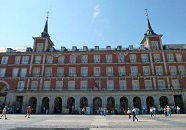2026 Autumn Budget event industry asks, event inclusion, and more
This month’s news highlights industry 2026 Autumn Budget asks, an industry driven by growth, accountability and inclusion. From economic gains to new standards and support...
The Portuguese chain, currently in the process of internationalising the brand in Europe, will be operating the luxury hotel in Plaza Mayor for at least 40 years.
Casa de la Carnicería stands in the centre of the south side of Madrid’s iconic square, Plaza Mayor. The four-storey building is topped by angular towers on the sides, a gabled top floor and an arcaded ground floor. It is very similar to Casa de la Panadería, just opposite, although the latter’s walls are decorated with frescoes, whereas the walls of Casa de la Carnicería are red. Nobody knows exactly how far back the original building dates, but it is thought that it was rebuilt in 1631 after a fire.
Hotel group Pestana has submitted the best financial proposal for the competition for awarding the contract for managing the future 5-star hotel based in Casa de la Carnicería, owned by Madrid City Council and situated in Plaza Mayor.
The Portuguese chain, currently in the process of internationalising the brand in Europe, will be operating the luxury hotel in Plaza Mayor for at least 40 years.
Casa de la Carnicería stands in the centre of the south side of Madrid’s iconic square, Plaza Mayor. The four-storey building is topped by angular towers on the sides, a gabled top floor and an arcaded ground floor. It is very similar to Casa de la Panadería, just opposite, although the latter’s walls are decorated with frescoes, whereas the walls of Casa de la Carnicería are red. Nobody knows exactly how far back the original building dates, but it is thought that it was rebuilt in 1631 after a fire.

Hotel group Pestana has submitted the best financial proposal for the competition for awarding the contract for managing the future 5-star hotel based in Casa de la Carnicería, owned by Madrid City Council and situated in Plaza Mayor.
The Portuguese chain, currently in the process of internationalising the brand in Europe, will be operating the luxury hotel in Plaza Mayor for at least 40 years.
Casa de la Carnicería stands in the centre of the south side of Madrid’s iconic square, Plaza Mayor. The four-storey building is topped by angular towers on the sides, a gabled top floor and an arcaded ground floor. It is very similar to Casa de la Panadería, just opposite, although the latter’s walls are decorated with frescoes, whereas the walls of Casa de la Carnicería are red. Nobody knows exactly how far back the original building dates, but it is thought that it was rebuilt in 1631 after a fire.